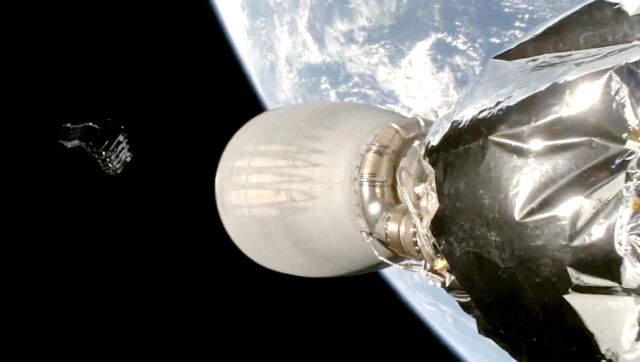21.10.2023
The rollout of Starlink-for-phones will add new demands to SpaceX’s launch schedule.
The goal next year is 12 launches per month, for a total of 144 Falcon rocket flights. Like this year, most of those missions will be primarily devoted to launching Starlink broadband satellites. So far in 2023, more than 60 percent of SpaceX's launches have delivered the company's own Starlink satellites into orbit.
"With our 2 million users, (we) need that constellation refreshed," the SpaceX official told Ars on background. "We're also going to look at direct to cell communications with Starlink, and that's a key feature that gets added next year with those 144 flights."
Here are some numbers. Last year, SpaceX launched 61 missions. In 2021, the number was 31. In the last 12 months, SpaceX has launched 88 Falcon rockets, plus one test flight of the company's much larger Starship rocket.
SpaceX's success in recovering and reusing Falcon 9 boosters and payload fairings has been vital to making this possible. SpaceX has gone past the original goal of launching each Falcon 9 booster 10 times before a major overhaul, first to 15 flights, and then recently certifying boosters for up to 20 missions. Technicians can swap out parts like engines, fins, landing legs, and valves that malfunction in flight or show signs of wear.
With so many launches planned next year, 20 flights is probably not a stopping point. "We might go a little higher," the SpaceX official said.
Engineers have shortened the time needed to reconfigure SpaceX's busiest launch pad in Florida to less than four days. SpaceX has also improved the turnaround time at its launch pad in California.
Supply chain management isn't as eye-popping as landing rockets on a floating platform in the middle of the Atlantic Ocean, but it's still important. SpaceX is ordering more components from suppliers in bulk and is asking its subcontractors to perform more quality inspections in the factory rather than SpaceX doing them after the parts are delivered.
Fundamentals of launch
"You can't increase that kind of number by just adding more bodies or extra shifts of work," the SpaceX official said. "You've got to fundamentally change the way you do business. You've got to fundamentally increase first pass yield, so there's less inspection needed later. The hardware is built more reliable from the get-go, so it's ready to go fly. It's forcing a ton of innovation into SpaceX that we would not do in any other way if we weren't driven by that flight rate."
From the outside, it can seem like SpaceX is rushing to each launch. But SpaceX says there's automation at every step, from launch processing to countdown operations, to post-flight data reviews, where engineers look for near-misses that may be harbingers of reliability concerns. Also, getting most of the rocket back after each flight allows for detailed inspections to catch little problems before they become big ones.
"I see the fight rate can only occur if I can increase reliability, so that they're not competing entities," the SpaceX official said. "So we end up with actually a safer system, more reliable system to enable that flight rate. It's a really cool thing to be challenged to do that, and we're building all kinds of electronic processes and tools, techniques and ways to communicate within the company to actually make that a reality, to fly those 12 flights each month."

Aside from Starlink, there may also be a small uptick in SpaceX missions next year for external customers, like NASA, the US Space Force, or commercial companies. External demand for Falcon 9 and Falcon Heavy launches is "steady," the official said, but some customers that had launches scheduled for this year encountered delays with their satellites, moving them into 2024.
"We saw some customers move out of this year, and some commercial customers move into next year," the SpaceX official said. "So that's driving some of the demand."
But the big driver is Starlink. SpaceX is rolling out the direct-to-cell capability, which it says will allow Starlink satellites to connect with normal smartphones, initially with texting coverage. That will be available to users beginning in 2024, according to SpaceX, followed by voice and data services in 2025. SpaceX says the Starlink-for-phones service "works with existing LTE phones wherever you can see the sky. No changes to hardware, firmware, or special apps are required, providing seamless access to text, voice, and data."
That would put Starlink in a different paradigm from legacy satellite phone companies, like Iridium and Globalstar. Those services require larger, specially designed handsets to allow a subscriber to place a voice call over the satellite network.
In 2022, when SpaceX and T-Mobile first announced the Starlink phone service, SpaceX founder Elon Musk suggested it would require much larger Starlink satellites that could only launch on the company's giant new Starship rocket. That rocket has taken longer to make operational than SpaceX expected, and Musk said earlier this month he expects Starship to be ready to carry Starlink satellites into orbit in roughly a year.
SpaceX developed an intermediate Starlink spacecraft design—bigger than the original Starlink satellites but smaller than the ones that will go on Starship—with additional throughput capacity to fly on the company's workhorse Falcon 9 rocket. Now, a new iteration of Starlink satellites enabled for direct-to-cell communications will also start flying on Falcon 9 because Starship isn't ready.
Ars reported last week that Starlink direct-to-cell upgrades planned in 2025 and 2026, like voice, data, and Internet of Things services, most likely depend on Starship getting up and running.
Quelle: arsTechnica

